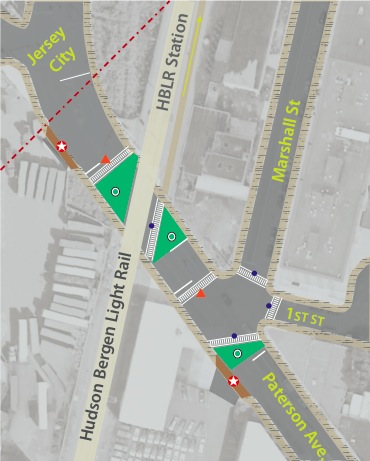
It's official. When it comes to livable streets, Hoboken is pulling out in front of every other New York City suburb. In some ways, the one-square-mile town is even lapping New York City. The latest in a string of envy-inducing projects under Mayor Dawn Zimmer and Parking and Transportation Director Ian Sacs is the city's new bike and pedestrian plan.
As the Tri-State Transportation Campaign's Zoe Baldwin writes, Hoboken has quickly emerged as a model of sustainable transportation policy in the last year. On Streetsblog, we've covered their Corner Cars program, which brings car-sharing to every corner of the small city by using on-street parking for shared vehicles; the Surrender Your Permit push, which offers a basket of incentives for residents who give up their cars; and the new 20's Plenty campaign, urging drivers to slow down for safety. There's also the revitalized shuttle bus service, the Hop, which has doubled in ridership since Zimmer took office a year ago.
Now, the city is developing a master bicycle and pedestrian plan. A draft is available online, and the public is invited to comment through this Monday. As currently written, the plan is an ambitious one. Here are just a few highlights from the document:
To calm traffic, extra-wide lanes would be narrowed, with the space reused for things like wider sidewalks or bike lanes. On-street parking could be repurposed for bike parking, sidewalk space, or parklets. New signage would sprout across the city, helping cyclists find their way (and remember to ride in the right direction) and reminding drivers of things like school zones or the right of cyclists to take a full lane. There'd be car-free Sundays on Sinatra Drive, and Observer Highway would be remade and renamed as Observer Boulevard.
But wait, there's more. Bike boxes, pedestrian countdown signals, and walking school bus routes would be a part of the city landscape. There would be bike racks on board the Hop, NJ Transit, the light rail, PATH, and ferries. Hoboken would start looking into ambitious projects like a Chicago-style bike station at the train station and a bike-sharing program. Pedestrians would enjoy Barnes Dances, in which there's a pedestrian-only signal phase, and raised intersections, which shift the grade of the vehicular grid rather than the pedestrian realm.
The bike-ped plan isn't even limited to these engineering changes. It calls for strict enforcement of speeding, and greater numbers of bike police patrols. There would be pedestrian decoy operations, where the police nab drivers who don't yield properly. Bicycle and pedestrian safety would be introduced into the school curriculum.
Perhaps most importantly, the plan calls for passing a special levy that would raise dedicated funds for bike and pedestrian programs, which could turn these ideas into a reality.





